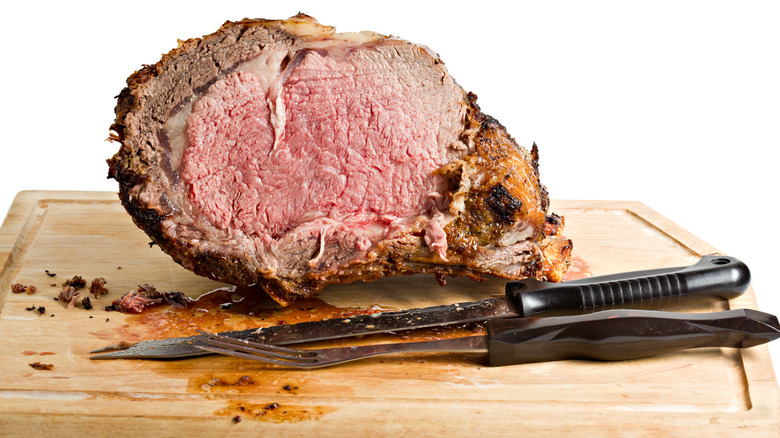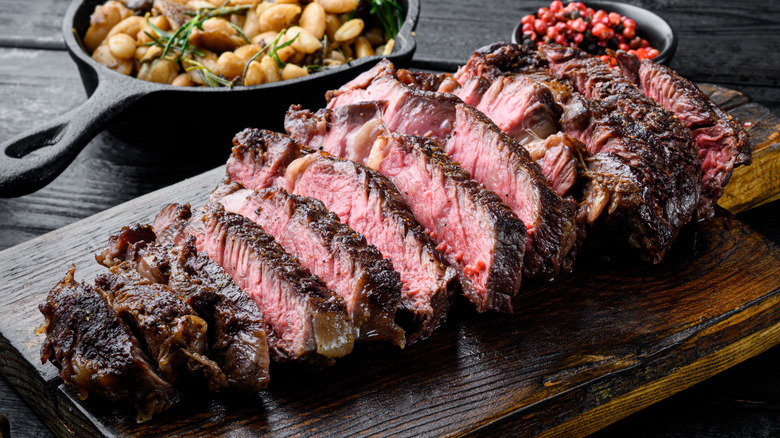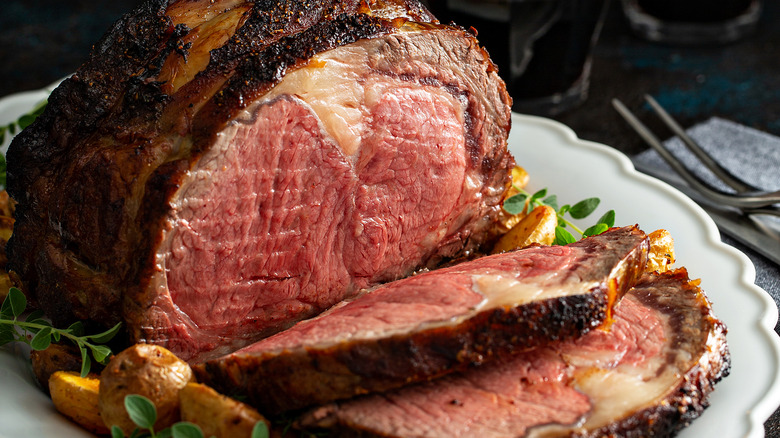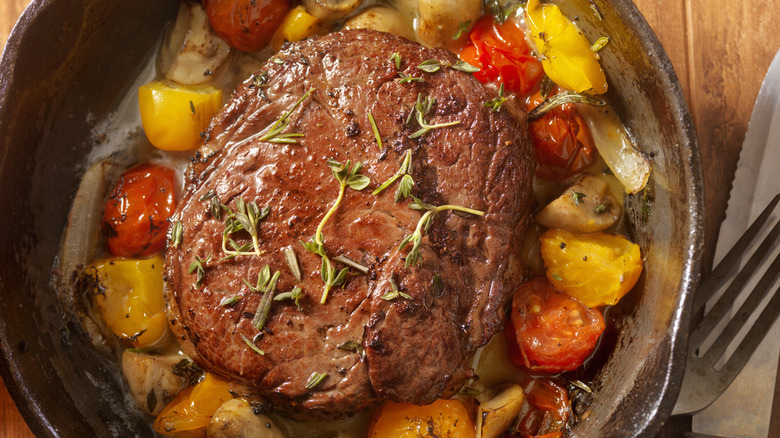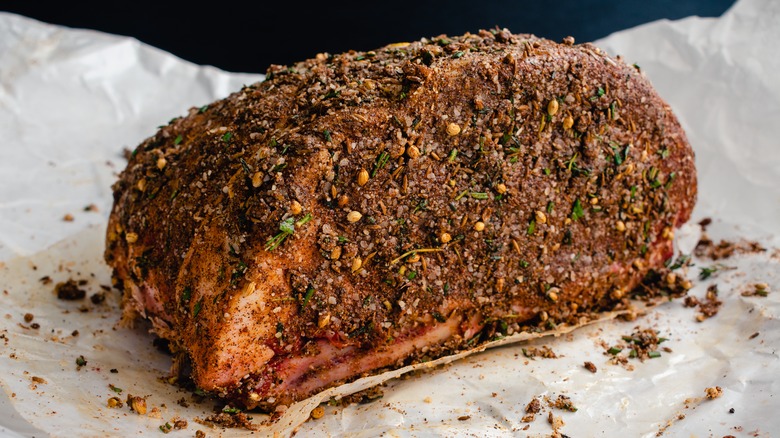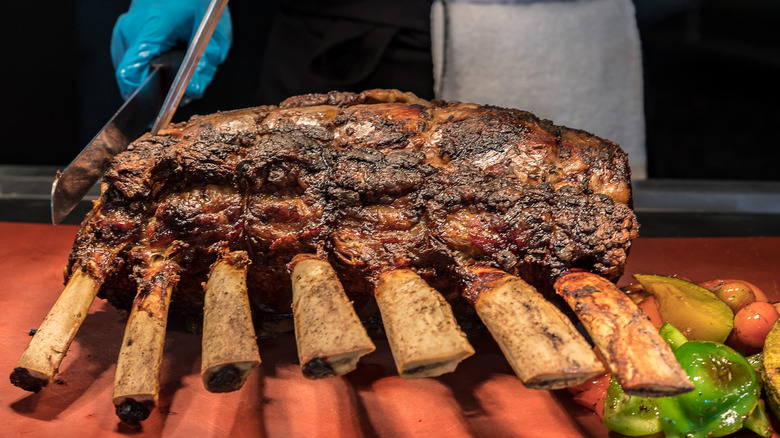Rib Roast Vs Prime Rib: What's The Difference?
Unless you're a butcher or a highly experienced carnivore, the many different cuts of beef available can be confusing. Commonly found at steakhouses and holiday parties, rib roasts and prime rib are two of the cow's most elite and expensive cuts. You may have gnawed on individual ribs from a rib roast at a Christmas gathering or eaten the cut as a ribeye steak with sides like mashed potatoes and creamed spinach. Prime rib is generally served with similar steakhouse sides, although it is also common to serve it by the slice au jus.
But what exactly are you eating when you munch on these fancy entrees? Both rib roast and prime rib come from the same part of the cow — the rib primal cut — and they can both feed a crowd, as you'll get way more meat from either of these cuts than you would from something like filet mignon. Still, there are notable differences between the two to keep in mind when making a purchase.
What is rib roast?
If you need to feed your whole family (and then some) for Christmas dinner, you may want to start with a rib roast. It can weigh up to a whopping 25 pounds and consists of the area between the short loin and the chuck. For those of us not as experienced in cow anatomy, that basically just means the space that holds the ribs. In total, cows have 13 ribs on each side of their bodies, and the whole area can refer to a rib roast.
This section of beef is so massive, it's often sliced into individual steaks known as ribeye steaks. These entrees can be served bone-in (which is also called rib steak) or boneless, although the latter is more common. As an added gourmet touch, they contain plenty of moisture-giving fat (aka marbling).
So you wouldn't typically order a full rib roast at a restaurant, but rather a cut of it, such as the aforementioned ribeye steak. You may also see this part of the cow served in the form of back ribs, short ribs, or a tomahawk steak.
What is prime rib?
While rib roast is a more general term that can lead to a few different types of beef entrees, prime rib is a more specific cut of meat, as it only refers to one part of the rib primal. It can get confusing to identify a prime rib because it goes by a few other names, including standing rib roast, export rib, and bone-in rib roast. But if you purchase prime rib, you'll get the meat and bones from ribs six through 12 of the rib primal cut. Since you're getting a whole rack of meat, you'll have plenty of food for a festive occasion — but at up to 16 pounds, prime rib often weighs less than an entire rib roast.
Where prime rib gets even more confusing is if you look at the word "prime" in its name. It's easy to assume this is one of the best cuts of beef because of the common association with the U.S. Department of Agriculture (USDA) prime grade, which is considered the highest quality of meat in the States. But while it is often counted as an elite selection of beef, prime rib simply refers to the cut, and you can find it in different quality grades.
Prime rib is typically cheaper than rib roast
Here's an easy way to remember that prime rib doesn't necessarily mean you're getting meat with a USDA prime grade: It's typically cheaper than rib roast. One reason for this is the size, since a prime rib typically consists of a smaller amount of beef. Standing rib roasts also have the bones removed more often than not, which makes more work for the butcher and usually means they're more expensive than bone-in prime rib. The butcher may take additional time to cut a rib roast into ribeye steaks or racks of short ribs before packaging the meat for you, which can factor into the extra cost as well.
The exception here is if you're ordering these cuts of meat at a restaurant. While a rib roast may cost more at the grocery store, you wouldn't order the entire rib primal section for a meal — so if you're getting a ribeye steak, for example, it'll typically be less expensive than prime rib when you're out to eat. At the butcher, prime rib is cheaper, but it takes longer to cook, so restaurants may charge a little more for the extra effort, as well as for the larger cut of meat they'll be serving you.
Prime rib has more natural flavor than rib roast
Depending on which cut of rib roast you buy, you'll end up with slightly different flavors of beef. Even different sections of prime rib can have varying tastes, and we'll have to look at our cow anatomy again to make the distinction. Ribs six through nine are called the large end rib roast, and they're closest to the chuck of the cow. They tend to have a bit more connective tissue and can be a little chewier, but they typically have more fat than the rest of the prime rib section, which results in more flavor. Ribs 10 through 12 of a standing rib roast are called the small end rib roast. While they may not have as much fat, this area of meat generally provides the best texture, as you'll find less gristle and a softer cut of beef.
But what about a rib roast? As we've mentioned, ribeye steaks come from the same section of the cow as prime rib, so they taste fairly similar. Since the bones are removed in the former, you're missing some of that natural flavor — but you can make up for it with the cooking and seasoning process. Rib roast and prime rib are usually cooked with similar seasonings, and butter, garlic, and herbs are all top contenders.
Prime rib takes longer to cook than rib roast
Since prime rib is a big hunk of meat with all the bones left in, while a rib roast tends to be divided into individual steaks, you'll cook these cuts of meat pretty differently. Just like other types of steaks, you can pan-fry or grill boneless ribeyes, and they have so much marbling that they don't require marinating beforehand. You'll want to first get a nice sear on the outside of the meat, and finish by cooking it at lower heat until it reaches the level of doneness you like. It should only take about 15 minutes to achieve a medium-rare steak, unless you get a bone-in ribeye, which will take more time.
Prime rib, however, is almost always cooked low and slow for a longer period of time than rib roast. The bones do more than just provide flavor here — they also help the meat stand upright (hence the name "standing rib roast") while it cooks, so the top layer of fat melts into the rest of the beef, keeping it nice and tender. Prime rib is typically roasted in the oven, which allows the meat to become even softer as it stews in its own juices. You'll want to allot a good portion of your day to let this cut of cow cook, as it could take up to five hours at 130 F until it's medium-rare.
